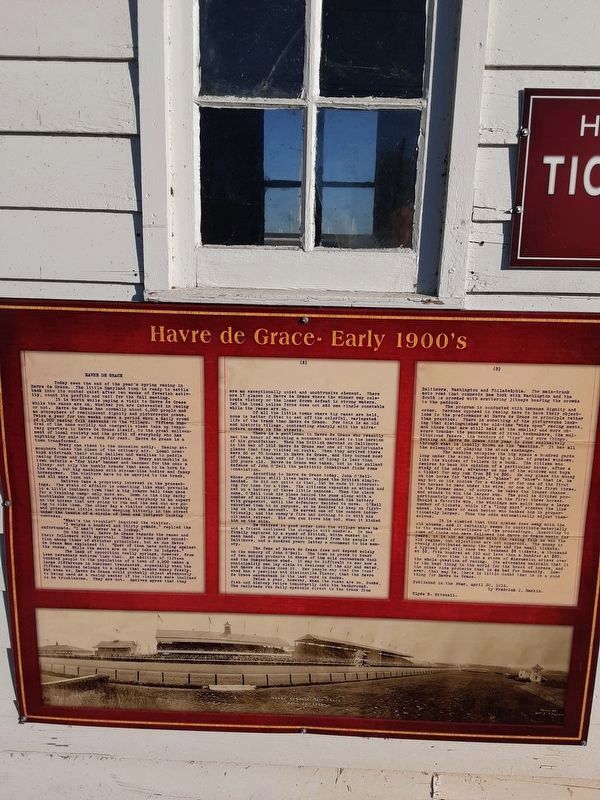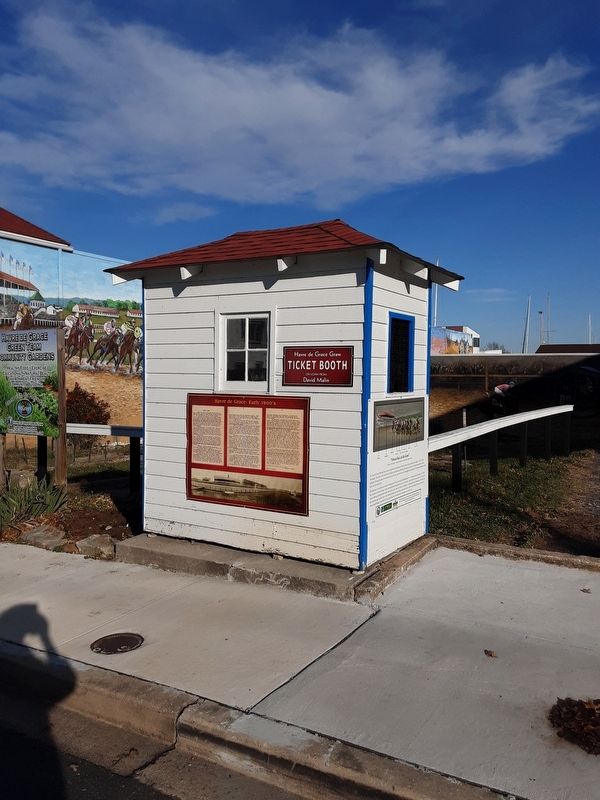Havre de Grace in Harford County, Maryland — The American Northeast (Mid-Atlantic)
Havre de Grace- Early 1900's
Today sees the end of the year's spring racing in Havre de Grace. The little Maryland town is ready to settle back into its wonted quiet after two weeks of feverish activity, count its profits and wait for the fall meeting.
It is worth while paying a visit to Havre de Grace while the races are on, whether you are interested in racing or not. Havre de Grace has normally about 4,000 people and an atmosphere of reminiscent dignity and picturesque peace. Twice a year for two weeks comes a period when a daily crowd of 6,000 racing folk descends on the village. Fifteen hundred of the same worldly and energetic class take up temporary quarters in Havre de Grace itself, to the great enlivenment of local society and the profit of everybody who has anything for sale or a room for rent. Havre de grace is a town transformed.
Every one rises to the occasion nobly. Racing atmosphere takes the place of the ordinary air. Local newsboys sidetrack their stock dailies and weeklies to peddle racing forms and kindred publications. Every automobile in town unfurls a "for hire” banner and becomes for the once a jitney- not only the humble brands that seem to be born to the work, but big machines with stream-line bodies and fancy horsepower. The visitors have to be carried to the track, and all cars turn out.
Natives take a propriety interest in the proceedings. The state of affairs is something like what prevails in a little Southern town that a big league ball team uses for a training camp- only more so. Down to the tiny darky bootblacks running about the streets, everybody is an expert on the horses that are going to run and the men who are going to ride them. The other day a visitor observed a chubby and prosperous little urchin weeping bitterly in the street under the taunts of a circle of lean and indigent looking comrades.
"What's the trouble?” inquired the visitor.
"I weighs a hundred and thirty pounds," replied the unfortunate. "I can't never be a jockey."
On the whole, Havre de Grace regards the races and their followers with approval. There is some quiet opposition among those of stricter principles, but as one Havre de Grace man explained it: "Most of them have nothing against the races. While the meets are on they take in lodgers."
The lack of opposition really springs, however, from less mercenary motives than that. An addition of fifteen hundred people to the population of a town of 4,000 makes a large difference in business transacted, especially when the fifteen hundred belongs to a class that spends money freely. But even so, Havre de Grace would probably object strenuously to being used as a racing center if the visitors were inclined to be troublesome. They are not. Natives agree that they are an exceptionally quiet and unobtrusive element. There are 17 places in Havre de Grace where the winner may celebrate victory or the loser drown defeat in strong waters. Yet the local police force does not add one single constable while the races are on.
Of all the little towns where big races are held, none is better fitted to set off the colorful, variegated life of the track than Havre de Grace. For this is an old and historic village, contrasting sharply with the ultra-modern crowds in the streets.
There is a gentleman in Havre de Grace who recently had the honor of watching a monument unveiled to the heroism of his grandfather. When the British marched on Baltimore in the war of 1812 Havre de Grace was one of the unfortunate places that they visited en route. When they arrived there were 60 or 70 houses in Havre de Grace, and they burned most of these, so that most of the town of today is less than 100 years old. Havre de Grace was taken, but in the gallant defense of John O'Neil the patriotic inhabitant finds some consolation.
According to Havre de Grace today, John O'Neil-whose grandson still lives here- w[h]ipped the British single-handed. He did not quite do that, but he made it interesting for them for a time. The citizens expected an attack and set up a battery of three little cannons. When the alarm came, O'Neil took his place behind the guns along with a number of militiamen. The British cannonaded the battery with grapeshot, until the defenders decided to move. O'Neil exhorted them to no purpose, so he decided to keep on fighting on his own account. He served one of the cannon industriously, and the enemy's fire had nothing to do with his ultimate retreat. His own gun drove him out, when it kicked him on the shin.
He retired in good order into the village where he and a friend continued the struggle with muskets. He was finally captured by a squad of British, with a musket in each hand. He got a presentation sword from the people of Baltimore, and a hundred years latter a monument to his memory.
The fame of Havre de Grace does not depend solely on the memory of John O'Neil. The town is prone to boast of two unique products in shape of the wild canvasback duck and the Susquehanna shad. It may be difficult to see how a municipality can lay claim to denizens of the air and water, but Havre de Grace does it. Her people say that the local shad has a peculiar and distinctive flavor, that the Havre de Grace canvasback is the last word in ducks.
Twice a year, however, when the races are on, ducks, fish and history retire temporarily into the background. The railroads run daily specials direct to the track from Baltimore, Washington and Philadelphia. The main-trunk auto road that connects New York with Washington and the South is crowded with scuttering Jitneys bearing the crowds to the paddock.
The program is conducted with immense dignity and order. Persons opposed to racing have to base their objections to the performance at Havre de Grace on principle rather than practice. There is something of the picturesque lacking that distinguished the old-time "wide open” racing meets, and those that are still held at the smaller and more obscure tracks- the pandemonium of rival bookmakers, the multitudinous fakers, the vendors of "tips” and sure things. Betting at Havre de Grace this year is done exclusively through what is locally known as the "machine." It has all the solemnity of playing the stock exchange.
The machine occupies the big space a hundred yards long under the stand, bordered by a line of grated windows, like the windows of tellers in a bank. The citizen who desires to back his opinion of a particular horse, after a study of the odds, advances on one of the windows and buys a ticket for any sum from $2 to $50. He may place his money on the horse for "straight,” "place” or "show" - that is, he may bet on his choice for a winner or for one of the first two horses to pass under the wire, or one of the first three. In the former case, of course, he takes the longer chance and stands to win the larger sum. The pool is divided proportionately among the tickets on the first three horses. Should a favorite win, the winnings are split among a large number of tickets, while if a "long shot” crosses the line ahead, the share of each bettor who backed him is proportionately larger. Thus the odds automatically adjust themselves.
It is claimed that this system does away with the old abuses, and it certainly seems to contribute materially to the general orderliness of the proceedings. According to some of those who have followed the Havre de Grace meets for years, it is not as popular with the racing folk as was the old regime, but objections are not apparent. The money is evenly distributed among the large and the small tickets. A typical pool will show two thousand $2 tickets, a thousand at $5, five hundred at $10 and less than a hundred at $50.
From time to time a storm of discussion arises over the whole question of racing. Its advocates maintain that it is the best thing in the world for the breed of horses, and the other side protests that it is bad for humanity. However, that may be, there is little doubt that it is a good thing for Havre de Grace.
Published in the Star, April 30, 1916.
By Fredriok J. Haekin.
Clyde B. Mitchell.
Erected by Havre de Grace Alliance, Lower Susquehanna Heritage Greenway, Maryland Heritage Areas Authority.
Topics. This historical marker is listed in this topic list: Sports. A significant historical date for this entry is April 30, 1916.
Location. 39° 32.857′ N, 76° 5.221′ W. Marker is in Havre de Grace, Maryland, in Harford County. Marker is on Market Street, 0.1 miles south of Congress Avenue, on the right when traveling north. Touch for map. Marker is at or near this postal address: 200 Congress Avenue, Havre de Grace MD 21078, United States of America. Touch for directions.
Other nearby markers. At least 8 other markers are within walking distance of this marker. Cal Rodgers (within shouting distance of this marker); 'We used to have a race track' (about 300 feet away, measured in a direct line); "Dream Race at the Graw" (about 300 feet away); Rochambeau Plaza (approx. 0.2 miles away); Out of the Flames (approx. 0.2 miles away); "The People of Havre de Grace" (approx. 0.2 miles away); War in the Chesapeake (approx. 0.2 miles away); Surprise Attack (approx. 0.2 miles away). Touch for a list and map of all markers in Havre de Grace.
Credits. This page was last revised on November 22, 2022. It was originally submitted on December 10, 2020, by Carl Gordon Moore Jr. of North East, Maryland. This page has been viewed 221 times since then and 8 times this year. Last updated on December 15, 2020, by Carl Gordon Moore Jr. of North East, Maryland. Photos: 1. submitted on December 10, 2020, by Carl Gordon Moore Jr. of North East, Maryland. 2. submitted on December 11, 2020, by Carl Gordon Moore Jr. of North East, Maryland. • J. Makali Bruton was the editor who published this page.

